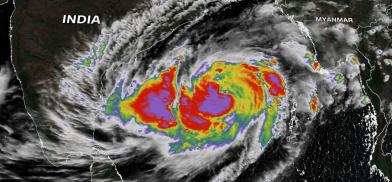Regional cooperation imperative in tackling Cyclone Mocha-type natural disasters
Cyclone Mocha only reminds us of the urgency of India-Bangladesh-Myanmar-Thailand-China-Sri Lanka cyclone management cooperation. As a start, Myanmar-Bangladesh-India trilateral cooperation is a must in this regard.

Myanmar is one of Bangladesh's closest neighbours, and the two countries have had a long-standing relationship. The 271-km long Bangladesh-Myanmar border is strategically significant for Bangladesh, despite the fact that it is militarized due to Myanmar's prolonged internal strife.
Relations between Bangladesh and Myanmar were formalized on January 13, 1972, when Myanmar became the sixth state to recognize Bangladesh as an independent entity. However, due to the presence of several unresolved issues, such as Rohingya refugees and maritime border demarcation, ties between the two have not always been as friendly as envisioned. But this time they need to come closer on the environmental front as Cyclone Mocha wreaks havoc in both countries.
On May 14, the extremely severe cyclonic storm hit the coastlines of Bangladesh and Myanmar, bringing with it heavy rains and high-velocity winds with a speed of 195 kmph. Cyclone Mocha, which was described as the second-most severe storm to form in the Bay of Bengal since 1982 and made landfall on Sunday (May 15) afternoon in Bangladesh and Myanmar’s Rakhine state near Sittwe township, tore off roofs and killed at least five people. According to media reports, Cyclone Mocha wrought devastation in Myanmar by damaging buildings, turning streets into rivers, uprooting trees, and flooding the coastal city of Sittwe.
In Bangladesh, authorities moved around 300,000 people to safer areas before the storm hit. Rohingya refugees inside densely-populated camps in Cox's Bazar in the southeast of the country hunkered down inside their ramshackle homes.
Vulnerability of coastal nations
As a strong storm pounded the Myanmar shore, thousands of people were evacuated to temples, pagodas, and schools around the country. Local media gathered videos that demonstrated how deep water rushed through streets while fierce winds whipped trees and tore boards off of rooftops. Aid agencies in Bangladesh and Myanmar say they are bracing for disaster and have launched a massive emergency plan as the powerful cyclone battered millions of vulnerable people.
Besides the major problems of poverty and illiteracy, Bangladesh and Myanmar’s vulnerability to environmental deterioration is alarming. The havoc caused by Cyclone Nargis in 2008 was the best example to understand it when both coastal countries were badly affected.
Environmentalists fear that climate change could cause more disasters, especially in Bangladesh, which is heavily populated. With Myanmar and Bangladesh bearing the brunt of cyclones regularly as a result of their location in the world's second-largest river basin, experts in both countries and the international arena are emphasizing the importance of taking an "integrated approach" and "regional cooperation" to mitigate the enormous economic and human costs.
Regional cooperation a must
Scientists from both nations, as well as perhaps India, Thailand, and Sri Lanka, as they are also a part of the Bay of Bengal, should work together to find answers to the issues.
China can also be roped in to cooperate with India, Bangladesh, Myanmar, Thailand, and Sri Lanka during such natural disasters. Cyclone Mocha only reminds us of the urgency of India-Bangladesh-Myanmar-Thailand-China-Sri Lanka cyclone management cooperation. As a start, Myanmar-Bangladesh-India trilateral cooperation is a must in this regard.
(The author is a Gauhati University, India-based researcher and analyst on the Indo-Pacific region. Views are personal. She can be contacted at drhazarikaarpita81@gmail.com)









Post a Comment